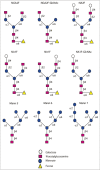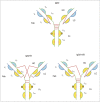Stability of IgG isotypes in serum
- PMID: 20404539
- PMCID: PMC2881250
- DOI: 10.4161/mabs.2.3.11788
Stability of IgG isotypes in serum
Abstract
Drug development from early discovery to late stage commercialization is a long arduous process where a number of factors are taken into consideration when deciding on a particular immunoglobulin isotype for a therapeutic purpose. There are no general rules for which isotype is selected; however, prior experiences, effector function and the specific therapy targeted, as well as extensive testing early in development help in pairing the number of candidates. Over 20 monoclonal antibodies are FDA-approved, and most are IgG1 isotype, although a number of non-IgG1 molecules have been approved recently and the number in development is on the rise. Analytical techniques that examine the physicochemical properties of a molecule provide vital information on the stability and efficacy of candidate antibody therapeutics, but most of these studies are conducted using standard buffers and under well defined storage conditions. It has recently become apparent that analysis of antibody therapeutics recovered after circulation in blood show altered physicochemical characteristics, and in many instances therapeutic molecules recovered from serum show lower potency. This review examines some of these studies, with a focus on the physicochemical changes observed in the molecules. Technologies that can facilitate rapid screening of candidate antibody therapeutics directly from blood are highlighted. The facts indicate that antibody therapeutic development programs must incorporate understanding of the basic biology of the isotype and its stability in serum, which is the intended environment of the therapeutic.
Figures








Similar articles
-
Effect of the ADCC-Modulating Mutations and the Selection of Human IgG Isotypes on Physicochemical Properties of Fc.J Pharm Sci. 2022 Sep;111(9):2411-2421. doi: 10.1016/j.xphs.2022.06.014. Epub 2022 Jun 26. J Pharm Sci. 2022. PMID: 35760121
-
When binding is enough: nonactivating antibody formats.Curr Opin Immunol. 2008 Aug;20(4):479-85. doi: 10.1016/j.coi.2008.05.010. Epub 2008 Jul 9. Curr Opin Immunol. 2008. PMID: 18577454 Review.
-
The isotype and IgG subclass distribution of anti-carbamylated protein antibodies in rheumatoid arthritis patients.Arthritis Res Ther. 2017 Aug 15;19(1):190. doi: 10.1186/s13075-017-1392-z. Arthritis Res Ther. 2017. PMID: 28810902 Free PMC article.
-
Bias in murine IgG isotype immobilisation. Implications for IgG glycoform analysis ELISA procedures.J Immunol Methods. 1996 Oct 16;197(1-2):109-20. doi: 10.1016/0022-1759(96)00122-6. J Immunol Methods. 1996. PMID: 8890898
-
Immunoglobulin isotype knowledge and application to Fc engineering.Curr Opin Immunol. 2016 Jun;40:62-9. doi: 10.1016/j.coi.2016.03.002. Epub 2016 Mar 23. Curr Opin Immunol. 2016. PMID: 27003675 Review.
Cited by
-
Engineering an improved IgG4 molecule with reduced disulfide bond heterogeneity and increased Fab domain thermal stability.J Biol Chem. 2012 Jul 13;287(29):24525-33. doi: 10.1074/jbc.M112.369744. Epub 2012 May 18. J Biol Chem. 2012. PMID: 22610095 Free PMC article.
-
A high throughput capillary electrophoresis method to obtain pharmacokinetics and quality attributes of a therapeutic molecule in circulation.MAbs. 2012 Jul-Aug;4(4):521-31. doi: 10.4161/mabs.20099. Epub 2012 Jul 1. MAbs. 2012. PMID: 22647389 Free PMC article.
-
Production, characterization, and pharmacokinetic properties of antibodies with N-linked mannose-5 glycans.MAbs. 2012 Jul-Aug;4(4):475-87. doi: 10.4161/mabs.20737. Epub 2012 Jul 1. MAbs. 2012. PMID: 22699308 Free PMC article.
-
Autoantibody-Abzymes with Catalase Activity in Experimental Autoimmune Encephalomyelitis Mice.Molecules. 2023 Jan 30;28(3):1330. doi: 10.3390/molecules28031330. Molecules. 2023. PMID: 36770997 Free PMC article.
-
IgG cooperativity - Is there allostery? Implications for antibody functions and therapeutic antibody development.MAbs. 2017 Nov/Dec;9(8):1231-1252. doi: 10.1080/19420862.2017.1367074. Epub 2017 Aug 16. MAbs. 2017. PMID: 28812955 Free PMC article. Review.
References
-
- Salfeld JG. Isotype selection in antibody engineering. Nat Biotechnol. 2007;25:1369–1372. - PubMed
-
- Carter PJ. Potent antibody therapeutics by design. Nat Rev Immunol. 2006;6:343–357. - PubMed
-
- Reichert JM, Rosensweig CJ, Faden LB, Dewitz MC. Monoclonal antibody successes in the clinic. Nat Biotechnol. 2005;23:1073–1078. - PubMed
Publication types
MeSH terms
Substances
LinkOut - more resources
Full Text Sources
Other Literature Sources
